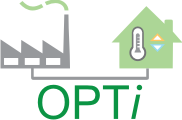
Details
Description
The OPTi project aspired to create a long-lasting impact by rethinking the way district heating and cooling (DHC) systems are architected and controlled. The overarching goal was to create business benefit for the industry as well as to ensure optimal end-consumer satisfaction.
OPTi delivered methodologies and tools that enabled accurate modelling, analysis and control of current and envisioned DHC systems. The methodology was deployed both on a complete system level, and on the level of a building(s).
OPTi treated the DHC system as a system subject to dynamic control and treated thermal energy as a resource to be controlled for DHC systems towards saving energy and reducing peak loads. This led to the most environmentally-friendly way of utilising energy sources, thus reducing the reliance on additional boilers running on oil and/or electricity and overall providing a socio-economically sustainable environment.
Map
Project demonstration sites
OPTi Site Palma de Mallorca
City
OPTi Site Lulea
City
Fellow cities
Lulea
Palma de Mallorca
Objective
OPTi helped energy companies to operate both today's and future DHC systems in an optimal way:
- on system level: opportunities for SMEs to provide new services/solutions were envisioned;
- on house level: more intelligent home DHC control systems like remote control and the consumer “virtual knob”;
- in general: the OPTi framework enabled engineers to design and plan DHC
In particular, the vision of OPTi included the following main pillars:
- Rethink DHC systems through an architecture that can be adapted in real-time to exogenous and unpredictable factors and dynamics
- Exploit the hidden potential of passive-heat storage, thus turning the household into a heat battery
- Develop automated heat Demand Response mechanisms that make the most efficient distribution and use of heat while minimizing DHC system operational costs
- Bring the user in the foreground by: (i) minimizing user discomfort (ii) placing emphasis on securing user engagement through appropriate viable incentive mechanisms
- Validate the principles and techniques above with data-driven approaches as well as with two real-life pilot trials in a hospital and in a block of residential buildings.
